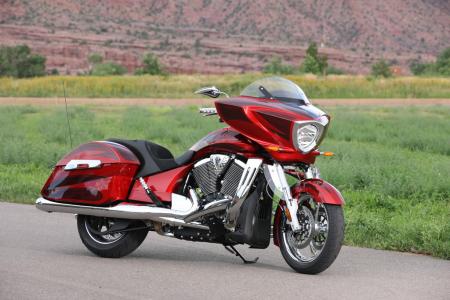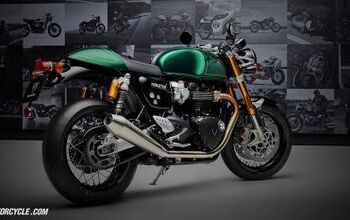2011 Victory Cross Country Review: Cory Ness Signature Edition - Motorcycle.com
Victory’s Cross Country touring cruiser has proved itself to be one of the best examples of its bagger breed, even in the face of stiff Harley-Davidson competition in the form of the successful Street Glide and Road Glide. When we compared a 2010 Cross Country to a Road Glide, the CC’s advantages in engine power, sure-footed handling, superior suspension and a lower price earned the Minnesota-based manufacturer a hard-fought victory.
More recently we pitted a 2011 Cross Country against Yamaha/Star’s Stratoliner Deluxe and Harley’s Street Glide with its optional 103-cubic-inch Power Pak motor in our 2011 Bagger Shootout, and the Vic outmuscled the hot-rod Harley and out-featured the YamaStar to emerge as best in class.
But when “best” isn’t good enough, Victory sends in the Ness family, headed by the illustrious Arlen Ness, one of the most famous motorcycle customizers in the business. The blinged-out signature Ness editions in Victory’s lineup are akin to Harley-Davidson’s aspirational CVO lineup, appealing to high rollers who want to stand apart from the crowd.
In the case of the Cross Country, it’s Arlen’s son Cory who adds his vision to the competent bagger. A longtime consultant with Victory, Cory Ness applied his touches to the Cross Country. It’s outfitted with Ness chromed billet grips, foot controls and passenger pegs, plus cool, diamond-cut cylinder fins. Mirrors, engine covers and the oil line cover are brightly chromed, as are the CC’s uniquely shaped highway bars. Billet “Anvil” wheels add further customization touches, as does the suede seat and a nicely done ghosting of the “Victory Motorcycles” logo under the paint’s clear coat.
It all adds up to a lofty $24,999 price tag. If that sounds a bit pricey, you probably haven’t shopped for the CVO version of Harley’s Street Glide. That high-end bagger retails for $32,499.
Even in non-Ness trim, the aluminum-framed Cross Country is packed with features, starting at $17,999 in solid black. Its frame-mounted fairing houses such niceties as an MP3-compatible AM/FM stereo, cruise control, separate tach and speedo, plus fuel and volts on individual gauges, augmented by an LCD info panel with a GPI. Standard hard saddlebags provide 25% more lockable storage than Harley’s bags.
But it’s the Ness-edition CC that really stands apart from the herd, as we found out when we rode it from Colorado to the Harley-centric Sturgis Rally.
This multi-state ride was on a 2011 model Ness Cross Country, but the bike remains mostly the same for the recently announced 2012 edition. The ’12 Nessie is delivered in a new Boardwalk Blue color with Ness graphics and now includes ABS despite being priced the same as 2011.
The Open Road
Our trip began in Gateway, Colorado, the site of Victory’s 2011 press launch. For a full rundown of the many changes for 2011, including its 106-cubic-inch motor added across the line and a redesigned transmission, check out our First Ride article that includes mini reviews of each bike in Victory’s lineup.
The Ness CC smoothly rumbles down the road, getting quickly up to speed despite carting around its considerable 800 pounds, slightly less than a Street Glide. The 106/6 powertrain cranks out more horsepower and torque than even H-D’s TC103, chugging away nicely from as low as 1500 rpm with smooth throttle response under a broad swell of power. Vibration can be a bit obtrusive at higher revs, but the torque-rich motor makes spinning up the V-Twin purely optional.
The new tranny’s helical-cut gears are much quieter than the previous whiny gears, especially noticeable in 6th gear when you want to rumble down the road in peace. Shifts are notchier and higher-effort than we expected from a newly designed gearbox, but gear swapping is more precise and direct than previous Victory transmissions. A new neutral-assist feature simplifies rolling to a stop and accessing neutral even after clutch degradation and helps extend Victory’s oil-change intervals from 3000 to 5000 miles.
Ergonomically, the Ness CC’s comfortable suede seat is located slightly closer to the bars than the stock saddle, and it’s placed 26.25 inches off the ground for the lowest seat height in its class. Legs of all sizes will find a contented position on its 18-inch floorboards, 4.5 inches longer than a Harley Road King’s. The accommodating reach to the bars leans the body slightly forward to a position that curves the spine, which transmits less road shock to sensitive vertebrae.
The Ness’ small windscreen suited my 5-foot-8 body, providing enough deflection to allow riding with my faceshield open. I also tested a CC with a taller accessory windscreen, but its larger size comes at the cost of style points and susceptibility to crosswinds. It also sent turbulent wind at helmet level when I sat high, so taller riders may want to avoid it.
As we learned in our Bagger Shootout earlier this year, the Cross Country’s suspension is the best in its class. Its 43mm inverted fork boasts 5.1 inches of travel, while the air-adjustable shock provides 4.7 inches of bump absorption. Compare that to the Street Glide’s 2.0 inches!
The Cross bikes have always impressed us with their solid and secure handling, and the Ness CC behaves just as well. Twisty-road navigation is aided by low-effort steering, and superior cornering clearance allows more lean angle than other baggers.
What feels like a high center of gravity makes the CC feel a bit tippy at a stop and at low speeds, but a rider quickly learns to trust its behavior. Our route near Dotsero, Colorado, unexpectedly took us down an unpaved road. For 35 miles we traipsed along a twisty dirt road, and the Vic shrugged it off like a barge-sized GS, powersliding out of corners gleefully.
All Victorys are fitted with Nissin 4-piston calipers and 300mm front discs, and they offer reasonably good feel at the lever thanks to braided-steel lines. A 300mm rotor and 2-piston caliper provide strong but controllable power at the rear. Our 2011 tester didn’t have the antilock-brake system that’s standard on 2012 Crosses.
The Ness CC is equipped with all the mod cons, including a stereo with iPod connectivity, self-canceling turnsignals and cruise control. Kudos to Victory for providing cruise as standard equipment (optional on Harleys and unavailable on the Star Stratoliner Deluxe), but it’s a fairly archaic system compared to modern ride-by-wire setups. It was sometimes reluctant to activate on the first press of the set button, and hills and wind caused cruising speeds to fluctuate.
Audio is a great companion on a road trip, and the Vic system performs quite well, although accessing an MP3 player’s menu selection is a bit cumbersome and its amp is a little weak for riding with earplugs. Victory says its saddlebags are the largest in its class, and the Cross Country also boasts the highest load capacity of 560 lbs.
For a bagger to be successful, it must be pleasing to the eye, whether you’re on Main Street USA or Lazelle Street in Sturgis. Perhaps Victory’s toughest critics are the Harley loyalists, the biggest voting bloc in Sturgis. We were impressed and a little surprised to receive many favorable remarks about the Ness CC from the fickle Harley crowd. Its angular riff on the familiar batwing fairing drew compliments, as did the streamlined rear end and dagger-like LED taillight. Thin LED turnsignals help tidy up its clean appearance. The diamond-cut cylinder fins were also a big hit.
Our tri-state run to Sturgis allowed plenty of time to find fault with the Ness CC, but this well-developed pack mule gave us little to gripe about. I wasn’t too keen on the knurled-billet handgrips, but they were actually more comfortable than expected. Its tinted mirrors are small but have a useful field of vision. I’d prefer a throttle with a shorter rotation and a more precise cruise control. Its only real failing is a lack of an integral steering lock.
The Ness CC was a perfect companion for a trek from Colorado to Sturgis. It possesses agility and power that can eat up a mountain road, and it’s comfy enough for 500-mile days in the saddle while hauling around a week’s worth of stuff and delivering tunes to your ears. The Ness version takes the base model’s solid attributes and adds a bevy of bling that lets it hold its head high in a sea of Harleys.
We believe the Cross Country platform is the best motorcycle Victory has ever produced, and the Cory Ness version makes the appealing bagger package even more alluring.
Related Reading
2011 Bagger Cruiser Shootout
2011 Kawasaki Vulcan 1700 Vaquero vs. 2011 Harley-Davidson Road Glide Custom
2011 Harley-Davidson CVO Street Glide Review
2011 Victory Motorcycles Lineup
2010 Harley-Davidson Road Glide vs. 2010 Victory Cross Country
2010 Victory Motorcycles Line-up Preview
All things Victory on Motorcycle.com
More by Kevin Duke





































Comments
Join the conversation